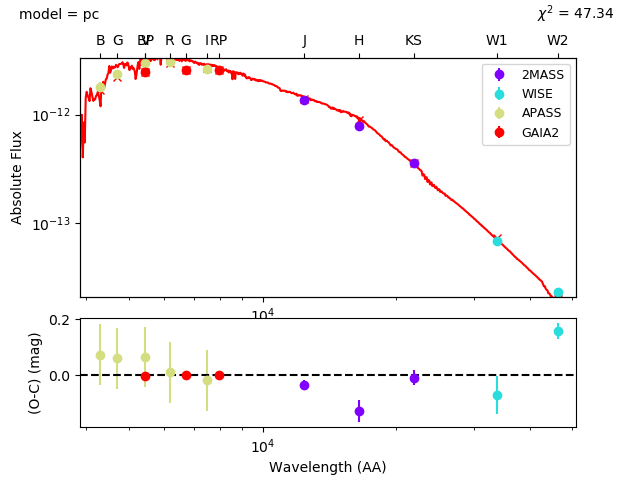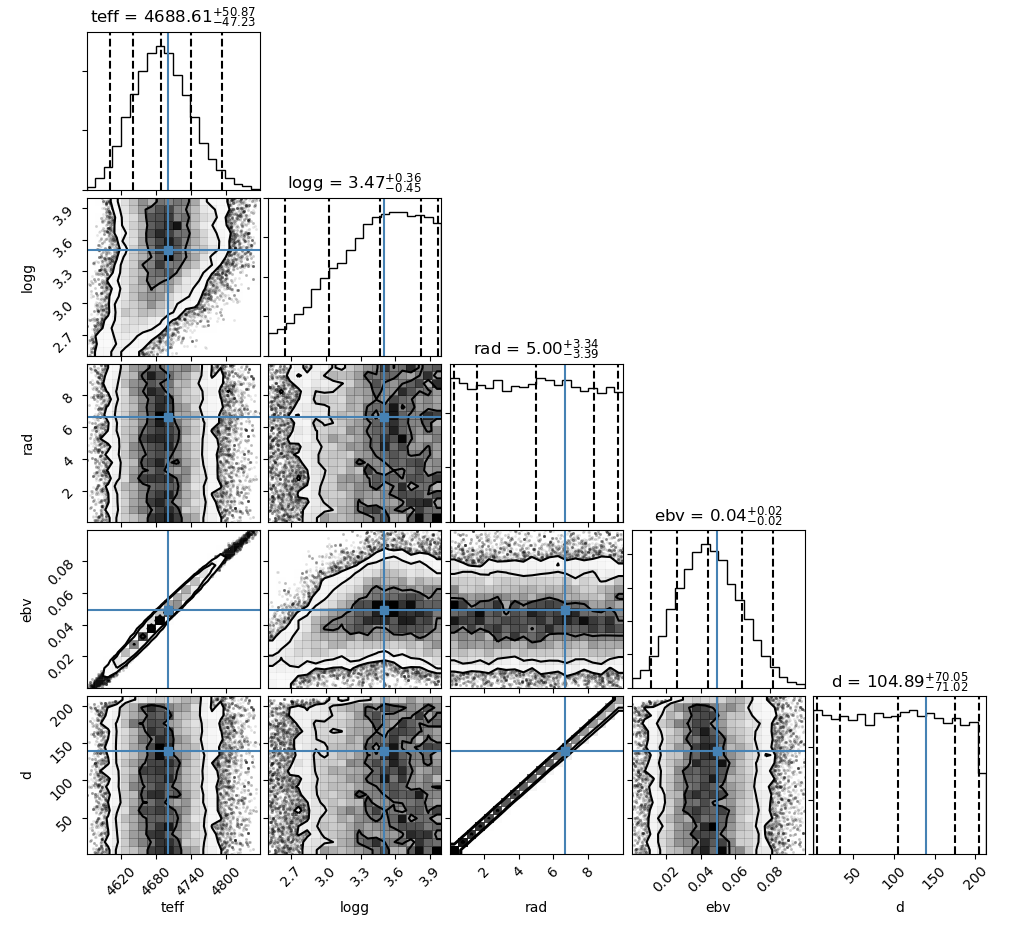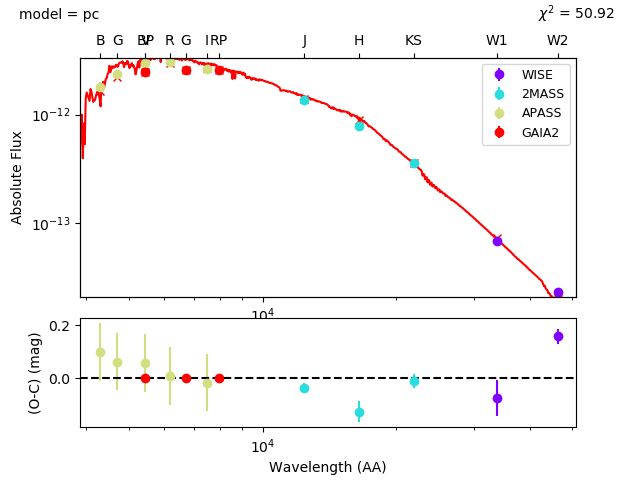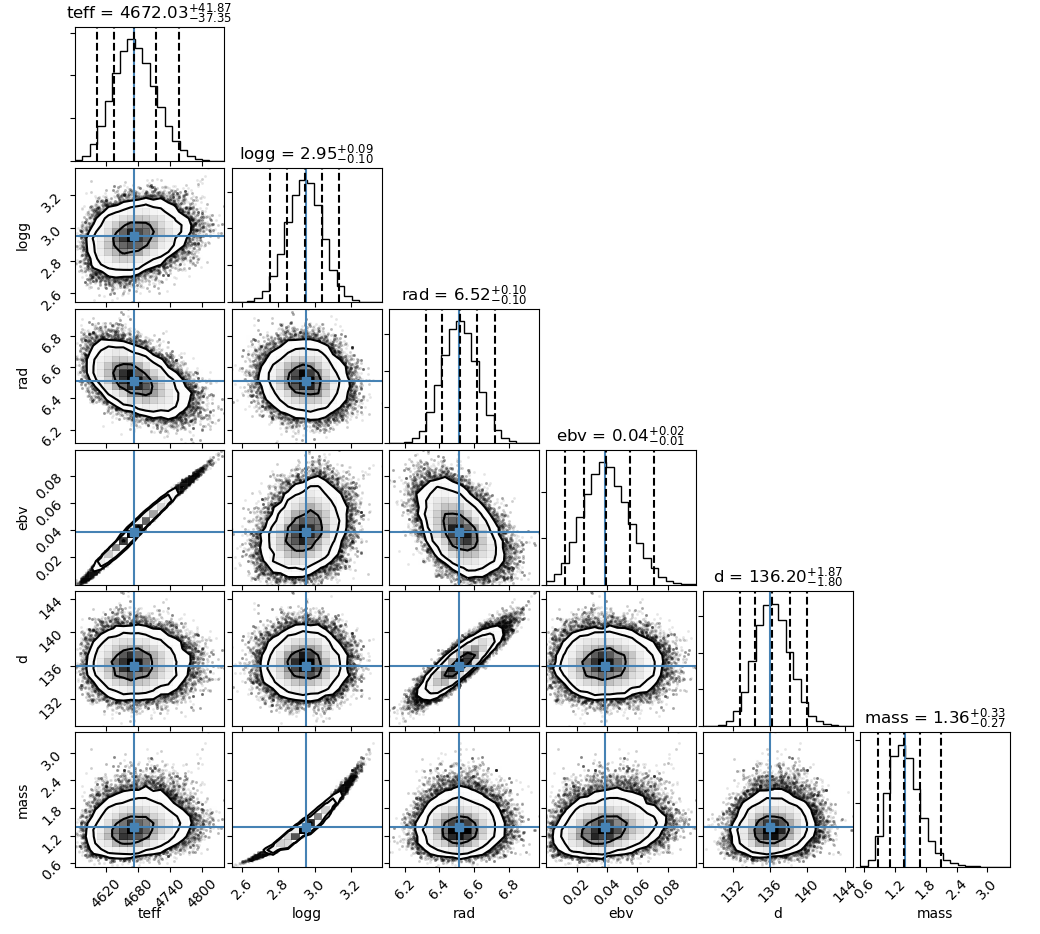Quickstart¶
To get you started immediatly, here is a description of how to fit the SED of the red giant HIP 4618. This system is in fact a red giant binary, but the companion is a brown dwarf and the SED is completely dominated by the primary.
Setup and searching for photometry¶
First we need to create a setup file containing all settings necessary for the fitting process, and we need to obtain photometry from the literature.
Speedyfit can automatically download photometry from several of the large surveys, and some smaller studies available on Vizier. By default only photometry from the following large and well calibrated surveys is obtained:
- Gaia DR2
- Sky Mapper DR1
- APASS DR9
- SDSS DR9
- Stromgren compilation catalog of Paunzen
- 2MASS
- WISE
You can create a default setup file and download photometry for a given object as follows:
speedyfit setup <object_name> -grid kurucz --phot
This will create a setup file called HIP_4618_setup_kurucz.yaml where you can setup the fitting parameters and a photometry file called HIP_4618.phot with the obtained photometry. The object name should be resolvable by simbad, or if that is not possible, a J-type coordinate. For example, to obtain photometry of the star ‘HIP 4618’ you could also have provided the coordinate as: ‘J005919.3-582417.5’
The ‘-grid’ option lets you determine which atmosphere model will be used for the fit. You can also change this by hand in the setup file later. Here we picked the ‘kurucz’ grid as it works well for giants.
The photometry file contains the following measurements:
| band | flux | eflux |
| GAIA2.G | 2.5868394603952325e-12 | 4.765134383579859e-16 |
| GAIA2.BP | 2.46735399163153e-12 | 3.636027212972875e-15 |
| GAIA2.RP | 2.55071491325932e-12 | 3.289013356019166e-15 |
| APASS.B | 1.7988585256582425e-12 | 1.7988585256582425e-13 |
| APASS.V | 2.942094782202632e-12 | 2.942094782202632e-13 |
| APASS.G | 2.336641341423516e-12 | 2.336641341423516e-13 |
| APASS.R | 3.0275544488430818e-12 | 3.027554448843082e-13 |
| APASS.I | 2.6320052051220464e-12 | 2.632005205122046e-13 |
| 2MASS.J | 1.3478059822453636e-12 | 2.3586127760129225e-14 |
| 2MASS.H | 7.890960003699894e-13 | 2.9071370348494806e-14 |
| 2MASS.KS | 3.5720112040912657e-13 | 8.882848761004847e-15 |
| WISE.W1 | 6.922838260043923e-14 | 4.399556963130625e-15 |
| WISE.W2 | 2.357855173591615e-14 | 6.080661822738957e-16 |
| WISE.W3 | 5.545248458540115e-16 | 7.661043691311934e-18 |
| WISE.W4 | 4.532380303499413e-17 | 1.3358325527436886e-18 |
Appart from the columns given above, which are used by speedyfit, also the catalog measurment and error, unit, distance to the target coordinates and the bibcode of the source are given.
Fitting the SED¶
The setup command created a default setup file where you can define the parameters of your fit. The default setup file for a single star fit with the kurucz grid looks as follows:
# photometry file with index to the columns containing the photbands, observations and errors
objectname: HIP_4618
photometryfile: HIP_4618.phot
photband_index: band
obs_index: flux
err_index: eflux
photband_exclude: ['GALEX', 'SDSS', 'WISE.W3', 'WISE.W4']
# parameters to fit and the limits on them in same order as parameters
pnames: [teff, logg, rad, ebv]
limits:
- [3500, 10000]
- [4.32, 4.32]
- [0.05, 2.5]
- [0, 0.1]
# constraints on distance and mass ratio is known
constraints:
parallax: [7.3467, 0.0996]
# added constraints on derived properties as mass, luminosity, luminosity ratio
derived_limits: {}
# path to the model grids with integrated photometry
grids:
- kurucz
# setup for the MCMC algorithm
nwalkers: 100 # total number of walkers
nsteps: 1000 # steps taken by each walker (not including burn-in)
nrelax: 250 # burn-in steps taken by each walker
a: 10 # relative size of the steps taken
# set the percentiles for the error determination
percentiles: [0.2, 50, 99.8] # 16 - 84 corresponds to 1 sigma
# output options
resultfile: HIP_4618_results_kurucz.csv # filepath to write results
plot1:
type: sed_fit
result: pc
path: HIP_4618_sed_kurucz.png
plot2:
type: distribution
show_best: true
path: HIP_4618_distribution_kurucz.png
parameters: ['teff', 'rad', 'L', 'ebv', 'd', 'mass']
There are a few things we would like to change here. By default the logg is fixed, because fitting the surface gravity from an SED is rather difficult, and usually won’t result in useful results. Lets try to vary it between logg = 2.5 - 4.0 anyway. For this we set the 2nd line of the limits parameters to [2.5, 4.0].
Since we know that we are dealing with a giant star on the lower part of the RGB, we have to change the range of the radius to R = 1 - 10 Rsol. So set the 3rd line of the limits parameters to [1.0, 10.0]
Lets also remove all constraints for now by setting constraints to an empty dictionary.
We are not interested in a csv output file, so remove the ‘resultfile’ parameter.
Finaly in the figure part, change the parameters of the distribution plot to: ‘parameters : [‘teff’, ‘logg’, ‘rad’, ‘ebv’, ‘d’]’ so that we also get the logg output.
The final file then looks like:
# photometry file with index to the columns containing the photbands, observations and errors
objectname: HIP_4618
photometryfile: HIP_4618.phot
photband_index: band
obs_index: flux
err_index: eflux
photband_exclude: ['GALEX', 'SDSS', 'WISE.W3', 'WISE.W4']
# parameters to fit and the limits on them in same order as parameters
pnames: [teff, logg, rad, ebv]
limits:
- [3500, 10000]
- [2.50, 4.00]
- [1.0, 10]
- [0, 0.1]
# constraints on distance and mass ratio is known
constraints: {}
# added constraints on derived properties as mass, luminosity, luminosity ratio
derived_limits: {}
# path to the model grids with integrated photometry
grids:
- kurucz
# setup for the MCMC algorithm
nwalkers: 100 # total number of walkers
nsteps: 1000 # steps taken by each walker (not including burn-in)
nrelax: 250 # burn-in steps taken by each walker
a: 10 # relative size of the steps taken
# set the percentiles for the error determination
percentiles: [0.2, 50, 99.8] # 16 - 84 corresponds to 1 sigma
plot1:
type: sed_fit
result: pc
path: HIP_4618_sed_kurucz.png
plot2:
type: distribution
show_best: true
path: HIP_4618_distribution_kurucz.png
parameters: ['teff', 'logg', 'rad', 'ebv', 'd']
Now lets run the fit:
speedyfit fit HIP_4618_setup_kurucz.yaml
You will get the following output:
Applied constraints:
distance = 136.11553486599425 - 1.845332907652827 + 1.845332907652827
100%|███████████████████████████████████████████████████████████████████████████| 1250/1250 [00:51<00:00, 24.36it/s]
================================================================================
Resulting parameter values and errors:
Par Best Pc emin emax
teff = 4699 4689 - 112 + 145
logg = 3.49 3.48 - 0.97 + 0.51
rad = 6.49 6.49 - 0.29 + 0.32
ebv = 0.049 0.044 - 0.043 + 0.051
mass = 4.72 4.67 - 4.15 + 10.81
d = 136 136 - 5 + 6
L = 18.38 18.26 - 1.72 + 2.19
scale = 0.000 0.000 - 0.000 + 0.000
chi2 = 45.404 48.315 - 2.789 + 12.119
And the following two figures get created:


As you can see, only the effective temperature and reddening are determined with any precision. The other parameters, logg, radius and distance, are not constrained at all. The derived temperature is also well in line with that determined from spectroscopic observations: Teff = 4750 +- 100 K Jones et al. 2011 A&A, 536, A71.
Constraints¶
There is a spectroscopic solution of this system available, so we can use that to constrain the effective temperature and surface gravity. And there is a parallax measurement available from Gaia DR2 which was automatically added to the setup file, but we removed it before. Let’s include it now. This is a good approach if you want to determine the radius and luminosity of the systems while also taking the errors on the spectroscopic parameters into account.
To do this we add the following lines to the constrained parameters in the setup file:
constraints:
parallax: [7.3467, 0.0996]
teff: [4750, 100]
logg: [2.91, 0.10]
We can also add the mass property to the output. Since we can derive the radius from the parallax and SED, and the surface gravity is included we can also determine the mass of the system.
We can now run the fit again:
speedyfit fit HIP_4618_setup_kurucz.yaml
Applied constraints:
teff = 4750 - 100 + 100
logg = 2.91 - 0.1 + 0.1
distance = 136.11553486599425 - 1.845332907652827 + 1.845332907652827
100%|███████████████████████████████████████████████████████████████████████████| 1250/1250 [00:57<00:00, 21.66it/s]
================================================================================
Resulting parameter values and errors:
Par Best Pc emin emax
teff = 4671 4674 - 96 + 129
logg = 2.94 2.95 - 0.28 + 0.27
rad = 6.52 6.51 - 0.28 + 0.30
ebv = 0.039 0.040 - 0.037 + 0.045
mass = 1.36 1.36 - 0.65 + 1.19
d = 136 136 - 5 + 6
L = 18.12 18.13 - 1.55 + 1.93
scale = 0.000 0.000 - 0.000 + 0.000
chi2 = 47.569 50.891 - 3.202 + 13.056


As you can see, the surface gravity is now constrained to more or less the same value as we provided for the prior. The same goes for the distance, as both these parameters can’t really be constrained from an SED fit alone. The effective temperature however is more of less the same as in the unconstrained fit. This is because the SED required a much smaller distribution than we gave in the prior. If you look at the SED, you can see this is most likely caused by the Gaia photometry which has very small errors. The radius has very small errors now, as the Gaia parallax is very precise. The mass parameters (which is not fitted, but included as a derived parameter similar to luminosity) is now also quite well constrained.
If you noticed the difference in errors between the terminal output, and the distribution figure. This is caused because both use different parameters to set those. The terminal output (and is requested also the results file) use the percentiles parameter, while the distribution figure has different parameters to set the percentiles. Have a look at the The setup file and Making figures documentation for more info.